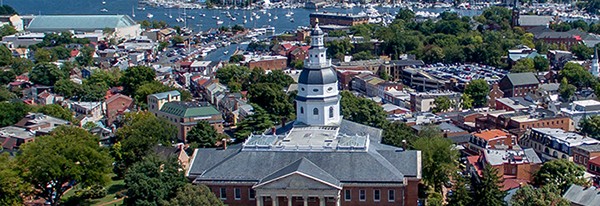Date:
Source: Capital Gazette, Brooks DuBose
The City Dock Action Committee presented its final report Tuesday to the Annapolis City Council, offering new details on a project that would remake the downtown area and how supporters plan to pay the estimated $50 million price tag.
The 122-page report — the final work of nearly 100 committee members — lays out the four-year plan to rebuild Hillman Garage, redevelop City Dock and install resiliency barriers. It suggests a host of funding streams such as federal and state emergency money, grants, private funding, among others.
A major portion of the report addressed short, intermediate and long-term effects of climate change in waterfront Annapolis, coastal flooding and sea-level rise. The plan calls for a variety of resiliency barriers that connect to the Naval Academy’s flood system at the end of Prince George Street and stretch around the harbor to Newman Street.
Former county budget officer John Hammond, head of the committee’s financing subgroup and a former alderman, helped craft some of the financial estimates in the report. The report suggests the entire project could range from $25-$50 million, depending on final costs.
The numbers in the report, are just that — numbers, and are subject to change, Hammond said.
“It could be less,” he said, “and you’ll never know until somebody does some preliminary engineering work.”
One concrete recommendation is raising the 7% hotel tax in Anne Arundel County and Annapolis by 1 percentage point. That would generate an estimated $3.4 million based on fiscal 2020 projections. The extra money would pay for a $50 million bond that would be issued to pay for the project.
“Before we get there, a lot of decisions have got to be made,” Hammond said. “The devil’s in the details and my history of Annapolis — 71 years — is the details are going to be very large and cause a great deal of discussion. There is a lot more work to be done. It’s a plan.”
Another major revenue stream could come from a county Resiliency Financing Authority. State Sen. Sarah Elfreth, D-Annapolis, said she plans to introduce a bill giving local jurisdictions power to creating such authorities, which fund projects tied to climate change and sea-level rise, Friday.
Robert Clark, President and CEO of Historic Annapolis, sat beside Mayor Gavin Buckley at the presentation at City Hall. Clark, Buckley and other stakeholders formed the committee last year. He expressed optimism about the next phase of the plan, as the committee hands off the report to the City Council.
“We have a sense of urgency. We have an extraordinary foundation to build on,” Clark said. “We are optimistic that the momentum will be carried forward into this implementation stage.”
Anne Arundel County Executive Steuart Pittman offered support for the proposal in a rare appearance at City Hall.
City Dock is the first step in addressing resiliency in Anne Arundel County and other counties, including Queen Anne’s and Charles counties, Pittman said. “If we can’t do City Dock, we’re really in trouble and we can’t do any of it.”
Hillman Garage
The four-year vision laid out in the report is already underway. The city issued a request for proposals to rebuild Hillman Garage and redevelop City Dock.
Five groups responded. Two were shortlisted in December and their proposals are due at the end of February, Annapolis Public Works Director David Jarrell said.
The winning firm will be announced on April 3. The firm that completes the Hillman Garage will also complete the City Dock work, Jarrell said.
He then laid out a rough timeline which indicates planning could begin on the garage as soon as this summer and construction could be completed by December 2022. If funding is secured, the entire project, including redeveloping City Dock, could be completed by late 2024.
The firms being considered to rebuild Hillman will include their construction costs in the coming months, Jarrell said.
Alderman Ross Arnett, D-Ward 8, asked committee members when the council would be able to offer input into the plan.
Buckley said their time would come once a firm is chosen for the project. “That will be our moment,” he said.
Alderman DaJuan Gay, D-Ward 6, questioned how African-American history would be included in the redevelopment and particularly about the location of the Kunta Kinte memorial. The ancestor of author Alex Haley, Kinte’s arrival aboard a slave ship in Annapolis was part of the novel and two television series, “Roots.”
Committee members assured Gay that the memorial would remain in place and that all voices would be included in the reimagined City Dock.
In addition to a natural barrier provided by a terraced lawn that will replace a parking lot along Dock Street and could be up to 8 feet tall, the report suggests flood walls, similar to those deployed in Washington, D.C.’s Georgetown neighborhood — where piers are permanently installed and floodwalls are deployed before an impending flood. A combination of passive or automatic systems such as glass floodwalls, flip-up barriers or self-closing barriers is also recommended.
In the short-term, the report calls on the city to continue funding temporary nuisance flood control measures on Dock Street and install similar measures on Compromise Street. It also encourages property owners in the area, including the Naval Academy, Fleet Reserve and Marriott hotel to coordinate their flood mitigation strategies.
Other items
The report also sketched out plans to:
- Install a curbless area including Market Space and a stretch of Dock Street beyond Craig Street to create a mixed-use space for public events and occasionally provide parking. The report recommends bollards be placed at the intersection of Craig and Dock streets to create a town square environment.
- Replace every parking spot removed from City Dock. To do so, the report calls for 106 spots to be relocated to the rebuilt Hillman Garage while retaining roughly 200 parking spots in and around City Dock.
- Include bike lanes in the downtown area during the engineering process as well as permanent bike storage areas and water fountains.


